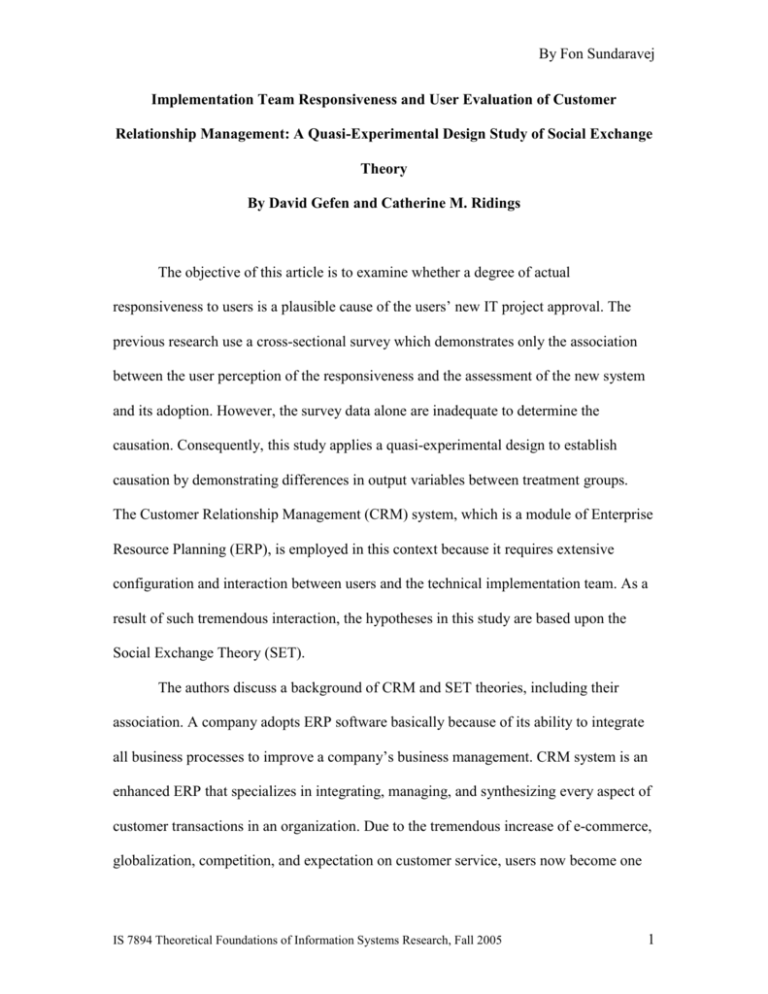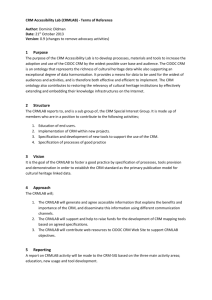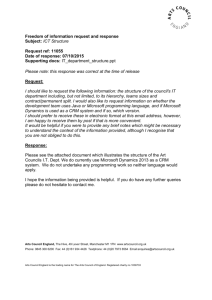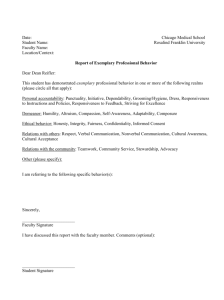Implementation Team Responsiveness and User Evaluation of
advertisement

By Fon Sundaravej Implementation Team Responsiveness and User Evaluation of Customer Relationship Management: A Quasi-Experimental Design Study of Social Exchange Theory By David Gefen and Catherine M. Ridings The objective of this article is to examine whether a degree of actual responsiveness to users is a plausible cause of the users’ new IT project approval. The previous research use a cross-sectional survey which demonstrates only the association between the user perception of the responsiveness and the assessment of the new system and its adoption. However, the survey data alone are inadequate to determine the causation. Consequently, this study applies a quasi-experimental design to establish causation by demonstrating differences in output variables between treatment groups. The Customer Relationship Management (CRM) system, which is a module of Enterprise Resource Planning (ERP), is employed in this context because it requires extensive configuration and interaction between users and the technical implementation team. As a result of such tremendous interaction, the hypotheses in this study are based upon the Social Exchange Theory (SET). The authors discuss a background of CRM and SET theories, including their association. A company adopts ERP software basically because of its ability to integrate all business processes to improve a company’s business management. CRM system is an enhanced ERP that specializes in integrating, managing, and synthesizing every aspect of customer transactions in an organization. Due to the tremendous increase of e-commerce, globalization, competition, and expectation on customer service, users now become one IS 7894 Theoretical Foundations of Information Systems Research, Fall 2005 1 By Fon Sundaravej of the most significant factors for a project success or failure. Thus, the success of the CRM implementation requires accurate and extensive configuration and responsiveness to users’ requests. In SET, an interaction between people is viewed as an exchange of intangible costs and benefits such as respect, honor, friendship, and caring. Such exchange cannot be managed by a rule or agreement. That means the reciprocal return from the investment of the other party is not guarantee. People have to rely on their trust in a cooperation of the other party. To deploy the CRM, the interaction between users and the implementation team contains some aspects of SET. The extensive responsiveness is a nature of CRM implementation. Users expect a positive relationship with the implementation team for a new IT system implementation that would help improve their work procedures. A high degree of the responsiveness, accordingly, is believed to result in the adoption of the CRM. The authors of this article construct several hypotheses based upon the association between two aforementioned theories. They assume that users who receive increased implementation team responsiveness will perceive higher degrees of implementation team responsiveness and cooperation intentions and will assess the correctness of the CRM configuration more favorably. The increased user perception of the implementation team’s responsiveness will also be associated with increased perception of the correctness of the CRM configuration and the implementation team’s cooperative intentions. Additionally, the authors believe that the increased user perception of the implementation team’s cooperative intentions will be associated with increased perception of the IS 7894 Theoretical Foundations of Information Systems Research, Fall 2005 2 By Fon Sundaravej correctness of the CRM configuration. At the end, such increased user perception of the correctness of the CRM configuration will result in a higher likelihood that the users will approve of the CRM. The study is made in a large telecommunications company based in the United States to assess a new CRM system adoption. In the quasi-experiment, each group or site receives a unique treatment. The outcomes of different sites will be measured and compared to assess whether the different treatments causes different outcome variables. The plausible causation, not only a correlation, can be assessed from the quasiexperiment design. The collected data from the experiment support most hypotheses of the authors. The result confirms that the configuration correctness affects the user approval and is affected by the perceived responsiveness and the cooperative intentions. The cooperative intentions are affected by the perceived responsiveness. This can be interpreted that the treatment group with a high degree of responsiveness from the implementation team perceives the intention of more responsiveness and cooperation. This treatment group also better assesses the CRM configuration and willingly adopts the CRM than the treatment group with simply routine support from the implementation team. It can be concluded from the experiment that the extensive interaction between users and the implementation team during the implementation of a CRM influences user assessments about the CRM and ultimately affects user willingness to adopt the system. Mangers gain benefits from this study by being aware that a user is an essential element to test the configuration correctness and system approval. To stimulate users’ belief about the new system, an accurate and prompt responsiveness from the IS 7894 Theoretical Foundations of Information Systems Research, Fall 2005 3 By Fon Sundaravej implementation team to the users’ requests is a key answer. On the other hand, an implementation team with a slow response to the users’ requests likely produces an unpleasant impression and incorporation from users. IS 7894 Theoretical Foundations of Information Systems Research, Fall 2005 4









